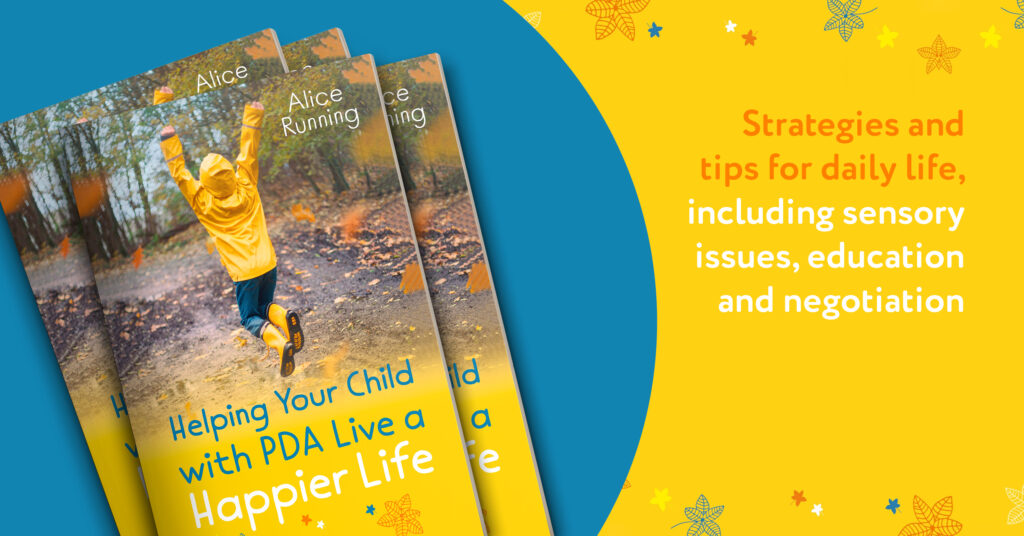Full of advice and support, Helping Your Child with PDA Live a Happier Life is not intended to provide information on how to change your children. Rather, it is focused on creating the type of environment that will allow children to be authentically themselves, thereby enabling them to flourish and thrive.

The importance of understanding the specific needs of a child with PDA
Pathological Demand Avoidance (PDA) is an autism spectrum condition. Although not yet contained within diagnostic manuals in its own right, Pathological Demand Avoidance is increasingly considered either a distinct condition or a co-occurring presentation falling under a wider diagnosis of autism.
Outcomes for PDA children can be poor. Often wrongly labelled as naughty, defiant, non-compliant, oppositional, lacking boundaries – all of which imply that the cause for such a presentation is behavioural, or a result of poor parenting.
PDA is rooted in anxiety. Persistent and pervasive anxiety makes complying with demands (either from an internal or external source) intolerable and as such, a person with PDA will go to extraordinary lengths to avoid having to comply with demands placed on them. It isn’t a choice to resist and avoid demands but an inability. Demands do not have to be large or unpleasant to be actively avoided. Even pleasurable demands can bring about distress because there is an expectation to comply, even if the compliance is with oneself.
A PDA child is an autistic child and will have needs relating to autism, for example, sensory processing differences or social communication differences. These needs will need to be effectively accommodated in order for a child to thrive. However, for an autistic child with demand avoidance some traditional autism “interventions” / methods of support may cause more distress because they specifically heighten already high anxiety levels to intolerable proportions.
Rather than supporting growth and emotional well-being, some generic autism strategies can create long term difficulty for a PDA child. This is why I am passionate about raising awareness and understanding around autistic demand avoidance and PDA. Behavioural or conditioning approaches aimed at creating compliance will never work for PDA children – such approaches will only exacerbate avoidance, and usually in extremity.
A PDA child will need accommodations made (to enable their participation) but may resist interventions if they are experienced as demands.
For example, a PDA child may experience higher sensitivity to noise and noise cancelling headphones may be helpful in reducing sensory distress. However, directly instructing a PDA child to use them may be counterproductive, resulting in an immediate rise in their anxiety because the instruction has been framed as a demand or expectation.

Visual timetables are another popular tool that are used with autistic children to help create routine and mitigate against the distress of unexpected surprise. PDA children do respond well to routine, structure and predictability but can often be overwhelmed when presented with such timetables as, to an anxious mind, schedules are demands.
PDA children can therefore be perceived as “complex” by those professionals seeking to support them, because they don’t respond to standard autism interventions in a typical way. Likewise, a PDA child can be further misunderstood as they seek to meet their own needs, and manage their own anxiety, by controlling environments external to them.
I write from personal experience. I am a parent to a PDA child who is a wonderful and loving human being but whose needs have never been fully recognised or understood by those professionals seeking to support him. Even with diagnostic reports and the recommendations of numerous experts, PDA-friendly strategies are rarely understood or used with my son. Instead, both he and I have been viewed as exaggerating or misrepresenting his needs when professional expectations of progress did not manifest. This is a worrying position to be in, and one that is unfortunately more common than it should be amongst families who support PDA children.
Without the correct support and understanding, life for a PDA child can become an ever-increasing cycle of extreme distress, impacting greatly on all areas of both their own and wider family functioning.
It is heart-breaking to watch your child struggle as misguided attempts at support cause your child further distress rather than help. Even seeking basic anxiety mental-health support for your child can feel like an impossible task, with outpatient appointments creating more demands to be actively avoided because they trigger an anxiety-based response.
This is why I wrote How to Help Your Child with PDA Live a Happier Life, in order to offer everyday strategies that are truly beneficial to an autistic child with anxiety-based demand avoidance. And to offer real-life experience – understanding from “the inside” – in the hope that greater understanding will create more positive outcomes for our children.
If you would like to read more articles like this and get the latest news and offers on our books about autism, why not join our mailing list? You may also be interested in our Facebook page or Twitter page.